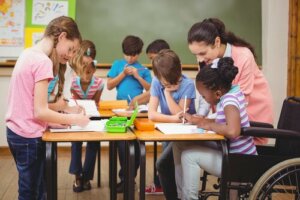Investing in Inclusive Education is a Safe Bet

According to the 1994 UNESCO Salamanca Statement, investing in inclusive education implies welcoming all people, regardless of their physical, intellectual, social, cultural, or gender conditions, into an educational system that suits their individual needs.
It’s a goal that integrates and includes students, teachers, family, local instances, and the environment overall. It’s about community work, one that ensures respect for human rights and democracy. Thus, it essentially claims a child’s right to education, equal opportunities, and non-discrimination or exclusion due to any of their differences.
The goal of inclusive education is to enable all people to actively participate both in their society and in the education of its members. Thus, it represents a kind of transformation of educational systems and centers in order to respond to students and their needs.
Furthermore, it’s about encouraging the promotion and acceptance of diversity as a fundamental value of learning. Thus, one could say that inclusive education represents a process and a challenge in terms of human rights.

Elements of inclusive education
According to Ainscow, an author, the four elements of inclusive education are:
- Inclusion in a process to find ways to effectively address diversity. This implies learning to live with differences and accepting diversity as a positive value within learning.
- Also, inclusion focuses on identifying and removing barriers that limit the participation and educational opportunities of students with disabilities. This involves assessing and planning for improvements in policy, educational practices, and school culture.
- This inclusion also places special attention on the groups of students at risk of exclusion, marginalization, or of not achieving optimal performance.
- Finally, inclusion comprises the participation, attendance, and performance of the entire student body.
Special educational needs
This concept arises from the attention to the different types of disabilities that require the participation of properly trained professionals. These must have the necessary support to conduct the school process.
However, in spite of the advances, the reality is that the educational system is far from responding effectively to the needs of people with disabilities.
Investing in inclusive education – normal vs. abnormal
Historically, people with disabilities have been segregated. There’s been a distinction between teachers for children without an identified disability and those who specifically work with disabled students.
It’s a separate educational model based on the pedagogical, psychological, and medical conceptions of the 19th and 20th centuries. These definitely influenced the educational practices that led to the consideration of disability as an abnormality.
This conception of normality-abnormality points to special education as a privileged place. In it, one must develop the methods and evaluations aimed at the “deficient”. This sort of blurs people with disabilities and moves them away from their social condition as subjects who can fully develop.

Necessary aspects for investing in inclusive education
According to authors Muñoz and Martuny, truly inclusive education must take into account the following:
- The diversity of learning styles. This is because not everyone learns the same way. Thus, an educator must generate creative strategies that enhance a student’s skills.
- Diversity is a fundamental variable and its value is also positive. One can’t allow a difference to be a disadvantage throughout the educational process.
- The diversity of rhythms. Everyone moves at a different pace and the assimilation of content and learning is no exception. In this regard, a lack of flexibility only creates the type of inequality that promotes exclusion.
- There’s also a diversity of interests, motivations, and expectations regarding school learning.
At the same time, one must take into account the diversity of capabilities and rates of development. All people develop specific abilities at different times and there’s no need to establish hierarchies. Every student, regardless of their characteristics, is capable of acting, taking an interest, and learning. However, you must understand they might require help, time, resources, and learning contexts adapted to their needs.
As you can see, inclusive education is the same as quality education for all students, regardless of their social, personal, cultural, or gender characteristics. Thus, society must work on progressively developing this type of education in order to promote the type of learning in which students can overcome any limits.
All cited sources were thoroughly reviewed by our team to ensure their quality, reliability, currency, and validity. The bibliography of this article was considered reliable and of academic or scientific accuracy.
- Unesco. (1994). Declaración de Salamanca y Marco de acción para las necesidades educativas especiales. http://www.unesco.org/education/pdf/SALAMA_S.PDF, 49. UNESCO: http://www.unesco.org/education/pdf/SALAMA_S.PDF
-
Tosi, I., Peláez, L., Larrañaga, M., Saavedra, E., & Baeza, E. (2016). Educación inclusiva y vida independiente= Inclusive education and independent living. UNIVERSITAS. Revista de Filosofía, Derecho y Política, 134-164.
- Ainscow, M. (2003). Desarrollo de Sistemas Educativos Inclusivos. Ponencia a presentar en San Sebastián. Estados Unidos: The University of Manchester: http://sid.usal.es/idocs/F8/FDO6565/mel_ainscow.pdf
- Martínez, M. E. (2008). Pedagogía de la Diversidad. Argentina: Universidad Nacional de la Plata. http://www.memoria.fahce.unlp.edu.ar/programas/pp.760/pp.760.pdf
- Lunardi, M. L. (2001). Inclusão/exclusão: duas faces da mesma moeda. Cadernos de Educação Especial, 2(18), 1-5.
- Muñoz, E., & Maruny, L. (2000). Respuestas Escolares. Educar en la Diversidad. Programa Diversidad y Escula Comprensiva: http://antoniopantoja.wanadooadsl.net/recursos/varios/resp_esco.pdf, 7. http://antoniopantoja.wanadooadsl.net/recursos/varios/resp_esco.pdf
This text is provided for informational purposes only and does not replace consultation with a professional. If in doubt, consult your specialist.








